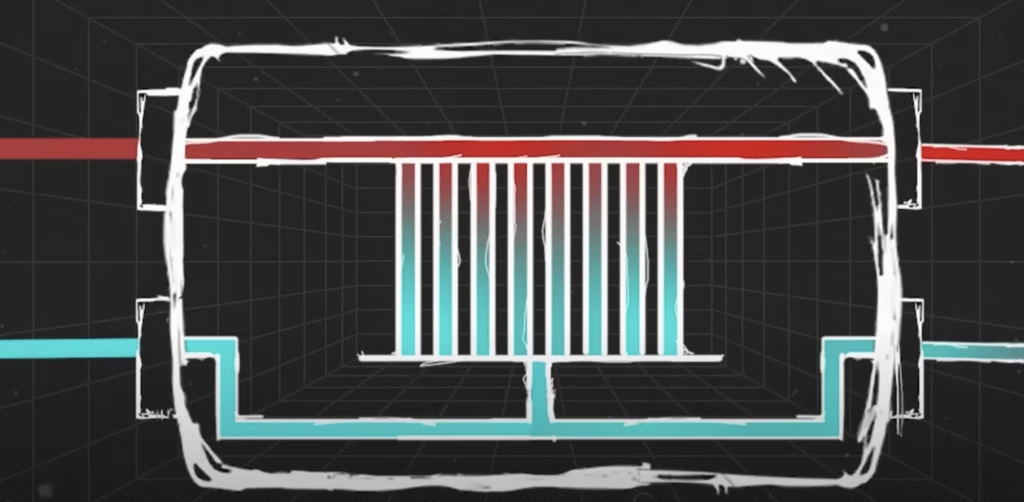The word ‘uranium’ often conjures images of catastrophic potential – from the long-lived radioactive waste and meltdowns witnessed at Fukushima, Three Mile Island, and Chernobyl, to the devastating power of atomic bombs. This pervasive unease has cast a long shadow over nuclear energy, creating an aura of taboo around uranium and the technology it powers. However, a potentially safer and more abundant alternative exists: thorium.
Thorium, three to four times more common in the Earth’s crust than uranium, promises significantly less radioactive waste, easier control to prevent meltdowns, and a much harder path to weaponization. These compelling advantages have fueled discussions about its potential, and recent developments, particularly China’s commissioning of the world’s first thorium molten salt reactor (MSR), signal a potential paradigm shift in nuclear energy. This technological leap, with China’s reserves potentially powering the nation for 20,000 years, necessitates a closer examination of how these reactors work and what they could unlock for our global energy future.
Understanding the Basics: How Nuclear Reactors Work
At its core, a nuclear reactor is a device designed to initiate and control a sustained nuclear chain reaction. This reaction, known as fission, involves splitting unstable heavy atomic nuclei, such as uranium or thorium, into lighter elements. This process releases a significant amount of energy in the form of heat, which nuclear power plants use to generate electricity.
The Principle of Fission
Nuclear fission is triggered when a neutron strikes an atom’s nucleus, causing it to become unstable and split. This splitting releases energy and more neutrons. These newly released neutrons can then strike other atomic nuclei, continuing the chain reaction. The controlled release of this energy powers a nuclear reactor.
Heat Transfer and Electricity Generation
The heat generated from fission is absorbed by a coolant circulating through the reactor core. In traditional reactors, this coolant is often water. The heated coolant then transfers its thermal energy to a secondary loop, typically used to produce steam. This steam drives a turbine, which is connected to a generator, ultimately producing electricity. Despite advancements in nuclear technology, the fundamental principle of using steam turbines to generate electricity has remained constant since the 1800s.

Molten Salt Reactors: A Safer, More Efficient Approach
Molten salt reactors (MSRs) represent a significant departure from conventional nuclear reactor designs. In MSRs, the fuel or coolant, or often both, are dissolved in a molten salt mixture. This fundamental difference offers several key advantages, particularly in terms of safety and efficiency. Unlike water-based reactors which operate under high pressure, like a boiling kettle ready to burst if its lid is forced, MSRs use molten salts that remain liquid at much higher temperatures, akin to oil in a deep fryer. This significantly reduces the risk of explosive steam release.
The Advantage of Molten Salt Coolants
Traditional nuclear reactors often use water as a coolant. While effective, water has a boiling point of 100°C, necessitating high-pressure containment systems. A failure in these systems can lead to the explosive conversion of superheated water into steam, causing significant damage, as witnessed in the Chernobyl disaster. MSRs, on the other hand, utilize molten salts with much higher boiling points, often exceeding 1400°C. This eliminates the need for high-pressure piping, drastically reducing the risk of explosive failures. In the event of a leak, both the coolant and fuel exit the reactor, mitigating the risk of a meltdown.
Continuous Operation and Fueling
The liquid nature of the fuel and coolant in MSRs allows for continuous circulation. This enables the addition of new fuel and the removal of fission products without shutting down the reactor. This contrasts sharply with solid-fuel reactors, which require costly and time-consuming shutdowns for refueling. Moreover, continuous removal of fission products, such as Xenon-135, which can absorb neutrons and destabilize the reaction in traditional reactors, also contributes to greater operational stability in MSRs.

Fail-Safe Design
A critical safety feature of many MSR designs is the use of a freeze plug. This plug, located below the reactor core, is kept cold to prevent the molten salt from escaping. In the event of a power failure, the cooling to the freeze plug ceases, causing it to melt and allow the molten salt to drain into subcritical tanks, where the nuclear reaction naturally stops. This passive safety mechanism is far simpler to implement than the extensive cooling systems required for solid-core reactors, which need continuous active cooling to dissipate residual heat for hundreds or even thousands of years.

The Compelling Case for Thorium as Nuclear Fuel
While the molten salt reactor design itself is compelling, the choice of thorium as a fuel source further enhances its appeal. Thorium, a naturally occurring radioactive element, possesses unique properties that make it an attractive alternative to uranium.
Thorium’s Abundance and Properties
Discovered by Jöns Jacob Berzelius in 1828 and named after the Norse god of thunder, thorium is significantly more abundant in the Earth’s crust than uranium, estimated to be three to four times more common. It primarily exists as thorium-232, an isotope with an extremely long half-life of over 14 billion years, making it technically unstable but decaying at an incredibly slow rate. This abundance is a significant advantage in securing a long-term energy supply.
From Fertile to Fissile: The Thorium Fuel Cycle
Thorium-232 does not directly fission, meaning it cannot sustain a nuclear chain reaction on its own. However, it is considered fertile because it can be converted into a fissile material. This conversion process, known as breeding, involves bombarding thorium-232 with neutrons. The thorium-232 absorbs a neutron to become thorium-233, which then undergoes beta decay to form protactinium-233. Another beta decay then transforms this into uranium-233, a fissile isotope capable of sustaining a nuclear reaction.
This breeding process can occur within the reactor itself when thorium is dissolved in the molten salt, with a small amount of uranium-233 added initially to kickstart the reaction.
Advantages of Uranium-233
Uranium-233, the product of the thorium fuel cycle, is an even more efficient nuclear fuel than uranium-235 or plutonium-239. It absorbs fewer neutrons per fission event, allowing it to produce slightly more neutrons, which can then be used to breed more uranium-233, creating a self-sustaining cycle. This inherent efficiency contributes to a more effective use of nuclear fuel.
Reduced Radioactive Waste and Actinides
One of the most significant advantages of thorium-based reactors is their production of significantly less long-lived radioactive waste compared to uranium reactors. Thorium produces fewer actinides, which are highly radiotoxic and have exceptionally long half-lives. It’s estimated that the nuclear waste from thorium reactors remains radioactive for around 500 years, a stark contrast to the 10,000 years or more for uranium waste. Furthermore, the volume of radioactive byproducts is reportedly 1,000 to 10,000 times less with thorium fuel.
The Global Pursuit of Thorium Reactors
Despite the clear advantages, the development of thorium MSRs has a long and complex history, with research in the United States dating back to the mid-20th century.
Historical Context and US Efforts
Research into molten salt reactors began in the United States after World War II, driven by initiatives like the Aircraft Reactor Experiment, which aimed for compact designs, and the Molten Salt Reactor Experiment (MSRE) at Oak Ridge National Laboratory. The MSRE, operated from 1965 to 1969, specifically focused on demonstrating a thorium fuel cycle in a breeder reactor.
Alvin Weinberg, then director of Oak Ridge, envisioned MSRs powering desalination plants as part of the Atoms for Peace program. However, these efforts were largely curtailed in the 1970s as the US shifted its focus to uranium-based reactors, partly due to their simpler technology and their ability to produce plutonium for weapons stockpiles. The MSRE is now considered a benchmark for modern thorium MSR research.
China’s Leading Role
While the US pioneered some of this research, the baton has clearly passed to other nations, with China taking a commanding lead in the development of thorium MSR technology. With vast thorium reserves, estimated to be sufficient to power the country for over 20,000 years, China has made substantial investments in research and development.
As early as 2011, they invested $450 million into a thorium salt reactor research program. The construction of the TMSR-LF1, an experimental thorium salt reactor inspired by the Oak Ridge design, began in 2018 and was completed in 2021. This reactor, located in the Gobi Desert, is primarily for research and has a thermal output of approximately 2 megawatts, not generating electricity. However, this pilot project has paved the way for larger, power-generating reactors.
Commercialization and Future Projects
China’s ambition extends to commercialization. A new thorium reactor project, announced as part of a construction plan, is scheduled for commissioning in 2025 and aims to be operational by 2029. This reactor will generate 60 megawatts of thermal power and will be part of a larger energy complex that includes solar, wind, and energy storage facilities, all integrated into a smart grid. Beyond this, China plans to develop commercial modular thorium reactors with capacities of 100 megawatts or more, with the goal of selling these reactors globally as part of its Belt and Road Initiative. This strategy positions China to become a superpower in nuclear power generation.
International Developments
Other nations are also pursuing thorium MSR technology. India, with significant thorium reserves and limited uranium, aims to generate 30% of its energy from thorium by 2050. Russia has also shown interest in thorium-based nuclear fuels. In the United States, Bill Gates’s TerraPower is collaborating with Oak Ridge National Laboratory to develop sustainable nuclear energy, including the Natrium reactor in Wyoming, which uses uranium but incorporates a novel sodium molten salt system for energy storage.
In Europe, initiatives like NuScale Power (US) and the Resolution (Netherlands) have formed strategic partnerships to advance MSR technology. NuScale plans an extra-small MSR generating around 40 megawatts, with mass production targeted for 2030, while Resolution is developing a 100-megawatt thorium MSR, with a pilot system expected by 2035.
Challenges and the Path Forward
With such compelling advantages, what stands in the way of thorium MSRs becoming the dominant force in nuclear energy? Despite the immense potential, several challenges must be addressed for thorium MSRs to become widespread.
Material Science and Corrosiveness
Molten salts are highly corrosive, posing significant challenges for the materials used in reactor components. Developing alloys and materials that can withstand these harsh conditions over long periods is crucial for the safe and reliable operation of MSRs.
Regulatory Frameworks
The regulatory landscape for commercial MSRs is still nascent. Establishing comprehensive safety protocols and licensing procedures for these novel reactor designs is a complex but necessary step for their widespread adoption.
Timelines and Ambition
While China’s ambitious timelines, such as the 2029 operational date for its first commercial thorium reactor, are commendable, they also highlight the need for realistic planning. Overly optimistic timelines have been a recurring issue with some advanced reactor projects. Balancing ambition with practical execution is key to success. China’s drive is partly fueled by a desire for carbon neutrality by 2060 and a strategic advantage in the global energy market. Their success in scaling up solar power, driven by subsidies and mass production initiatives, demonstrates their commitment to achieving technological feats rapidly.
Economic Viability
The cost-effectiveness of thorium MSRs compared to existing energy sources needs to be thoroughly demonstrated. While the fuel itself is abundant, the initial investment in research, development, and construction of these advanced reactors is substantial. The success of projects like China’s integrated energy complex, aiming for low-cost, low-carbon electricity for industrial production, will be critical indicators.
What Can You Do?
The development of thorium molten salt reactors is a rapidly evolving field with significant implications for the future of energy. Staying informed about these advancements and engaging in discussions about nuclear energy policy can contribute to a more informed public discourse. Supporting organizations and initiatives focused on advanced nuclear technologies can also play a role in accelerating their development and deployment.
Disclaimer
This article discusses various aspects of nuclear energy, including specific terminology. For clarity, the following common terms are used in the context of this discussion:
- Fission: The process of splitting an atomic nucleus, releasing energy.
- Neutron: A subatomic particle with no electric charge, crucial for initiating and sustaining nuclear reactions.
- Coolant: A substance circulated through a nuclear reactor to remove heat.
- Isotope: Atoms of the same element with different numbers of neutrons.
- Half-life: The time it takes for half of a radioactive substance to decay.
- Fertile Material: Material that can be converted into fissile material through neutron absorption.
- Fissile Material: Material capable of sustaining a nuclear chain reaction.
- Actinides: A group of heavy metallic elements, many of which are radioactive and have long half-lives.
- Molten Salt Reactor (MSR): A type of nuclear reactor where the fuel or coolant is dissolved in a molten salt.
- Thorium: A naturally occurring radioactive element used as a potential fuel for nuclear reactors.
- Uranium: A naturally occurring radioactive element commonly used as fuel in nuclear reactors.
- Uranium-233: A fissile isotope produced from thorium, suitable for nuclear fuel.
- Subcritical: A state where a nuclear chain reaction cannot be sustained.
- Carbon Neutrality: Achieving a balance between emitting carbon and absorbing carbon from the atmosphere.
Read Is Whale Song a Language as Complex as Our Own?
Read more about Quantum Navigation: Beyond GPS Vulnerability.
This article was created using Video Blogify!

